MAE302 T1 2018 Macroeconomics: Analyzing Open Economies Dynamics
VerifiedAdded on 2023/06/14
|8
|1509
|83
Homework Assignment
AI Summary
This assignment delves into the macroeconomics of open economies, specifically examining the relationship between the US and Australia. It analyzes how changes in interest rates on US deposits affect the Australian exchange rate, demonstrating that an expected rise in US interest rates depreciates the Australian dollar. The assignment further explores the impact of a permanent decrease in the US money supply, noting its short-term effects on trade and exchange rates and long-term adjustments through monetary policy. Finally, it discusses the interplay of interest rates and exchange rates, highlighting Australia's economic stability and ability to withstand US Federal Reserve policy changes. The document uses figures to illustrate key economic concepts and provides a comprehensive overview of open economy dynamics.

Running head: MACROECONOMICS OF OPEN ECONOMIES
Macroeconomics of open economies
Name of the student:
Name of the University:
Author note
Macroeconomics of open economies
Name of the student:
Name of the University:
Author note
Paraphrase This Document
Need a fresh take? Get an instant paraphrase of this document with our AI Paraphraser
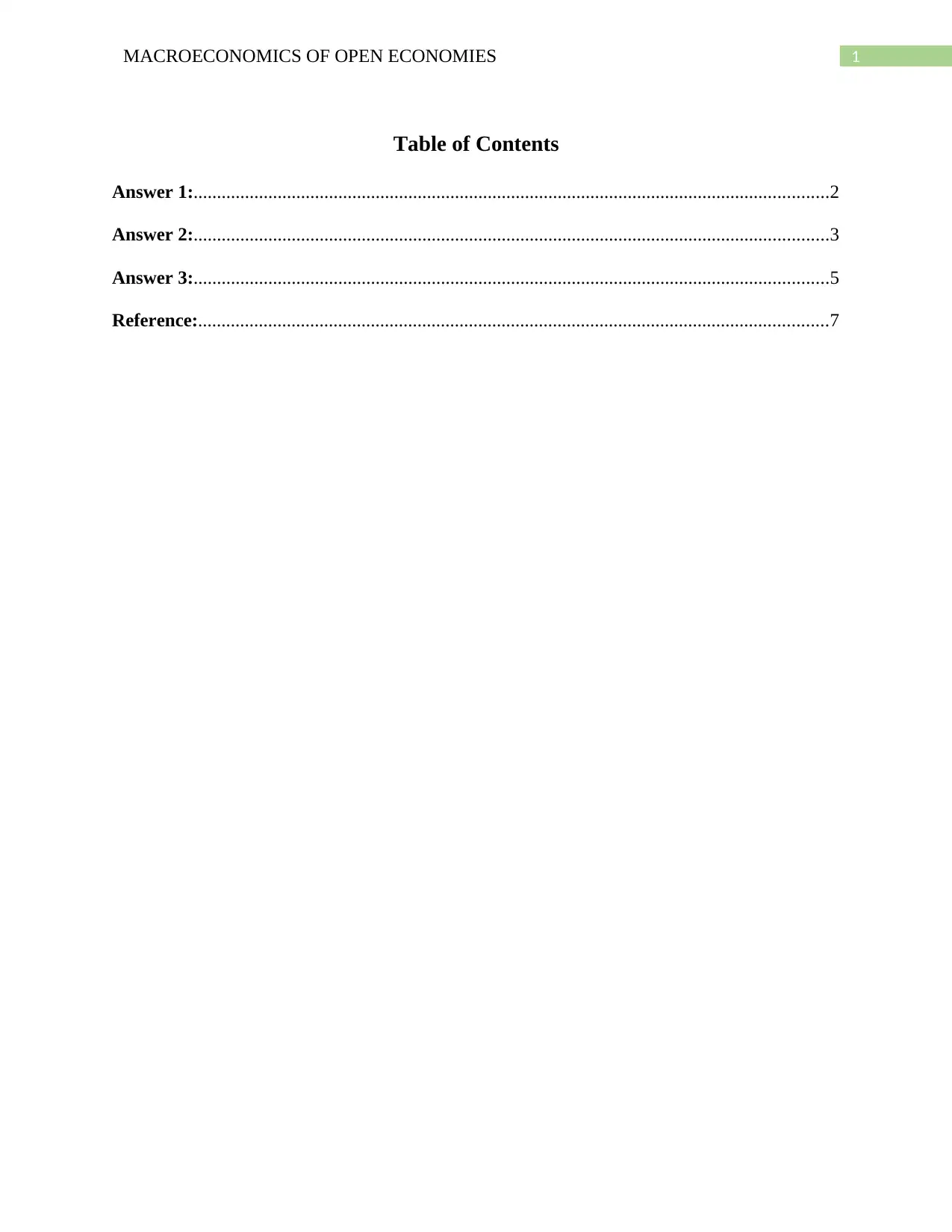
1MACROECONOMICS OF OPEN ECONOMIES
Table of Contents
Answer 1:........................................................................................................................................2
Answer 2:........................................................................................................................................3
Answer 3:........................................................................................................................................5
Reference:.......................................................................................................................................7
Table of Contents
Answer 1:........................................................................................................................................2
Answer 2:........................................................................................................................................3
Answer 3:........................................................................................................................................5
Reference:.......................................................................................................................................7
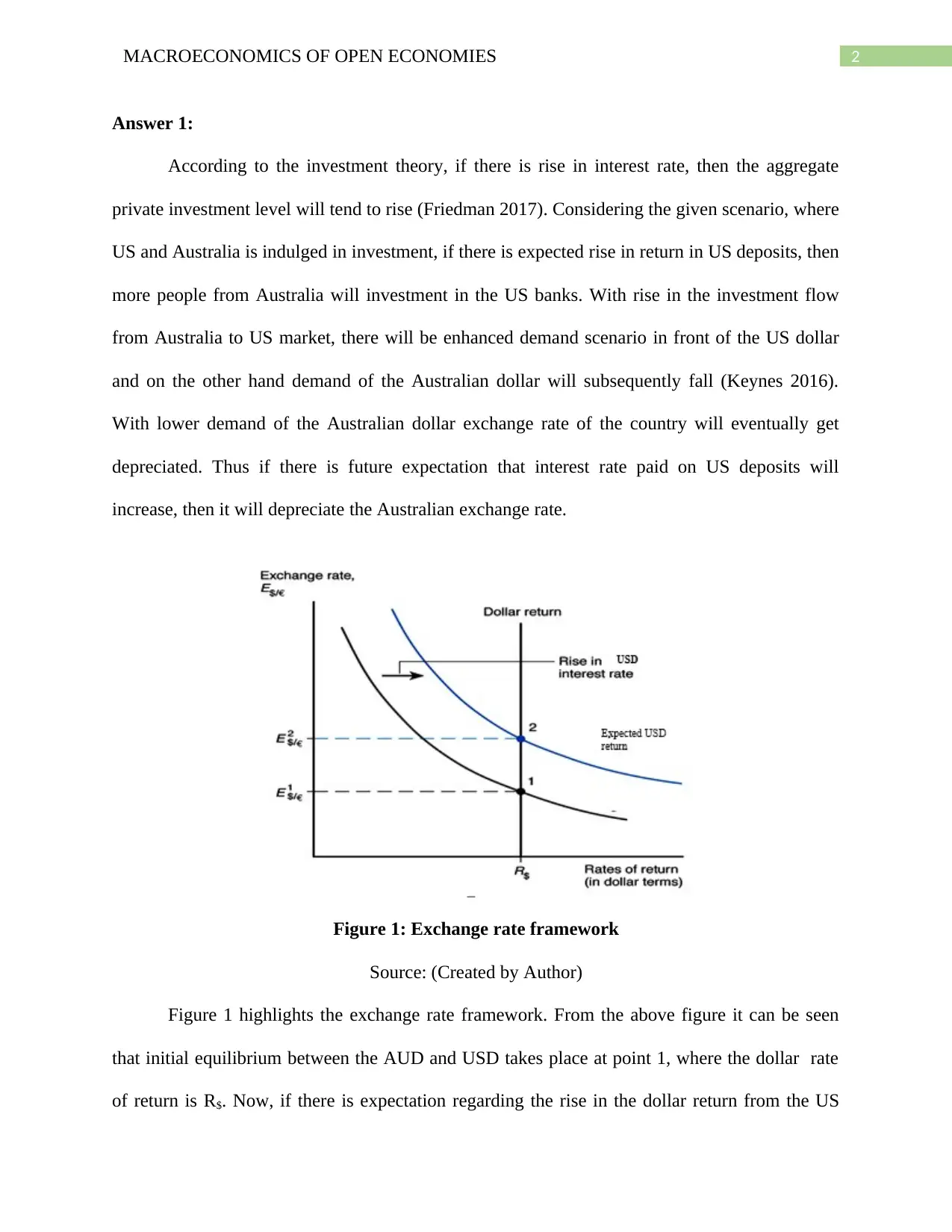
2MACROECONOMICS OF OPEN ECONOMIES
Answer 1:
According to the investment theory, if there is rise in interest rate, then the aggregate
private investment level will tend to rise (Friedman 2017). Considering the given scenario, where
US and Australia is indulged in investment, if there is expected rise in return in US deposits, then
more people from Australia will investment in the US banks. With rise in the investment flow
from Australia to US market, there will be enhanced demand scenario in front of the US dollar
and on the other hand demand of the Australian dollar will subsequently fall (Keynes 2016).
With lower demand of the Australian dollar exchange rate of the country will eventually get
depreciated. Thus if there is future expectation that interest rate paid on US deposits will
increase, then it will depreciate the Australian exchange rate.
Figure 1: Exchange rate framework
Source: (Created by Author)
Figure 1 highlights the exchange rate framework. From the above figure it can be seen
that initial equilibrium between the AUD and USD takes place at point 1, where the dollar rate
of return is R$. Now, if there is expectation regarding the rise in the dollar return from the US
Answer 1:
According to the investment theory, if there is rise in interest rate, then the aggregate
private investment level will tend to rise (Friedman 2017). Considering the given scenario, where
US and Australia is indulged in investment, if there is expected rise in return in US deposits, then
more people from Australia will investment in the US banks. With rise in the investment flow
from Australia to US market, there will be enhanced demand scenario in front of the US dollar
and on the other hand demand of the Australian dollar will subsequently fall (Keynes 2016).
With lower demand of the Australian dollar exchange rate of the country will eventually get
depreciated. Thus if there is future expectation that interest rate paid on US deposits will
increase, then it will depreciate the Australian exchange rate.
Figure 1: Exchange rate framework
Source: (Created by Author)
Figure 1 highlights the exchange rate framework. From the above figure it can be seen
that initial equilibrium between the AUD and USD takes place at point 1, where the dollar rate
of return is R$. Now, if there is expectation regarding the rise in the dollar return from the US
⊘ This is a preview!⊘
Do you want full access?
Subscribe today to unlock all pages.

Trusted by 1+ million students worldwide
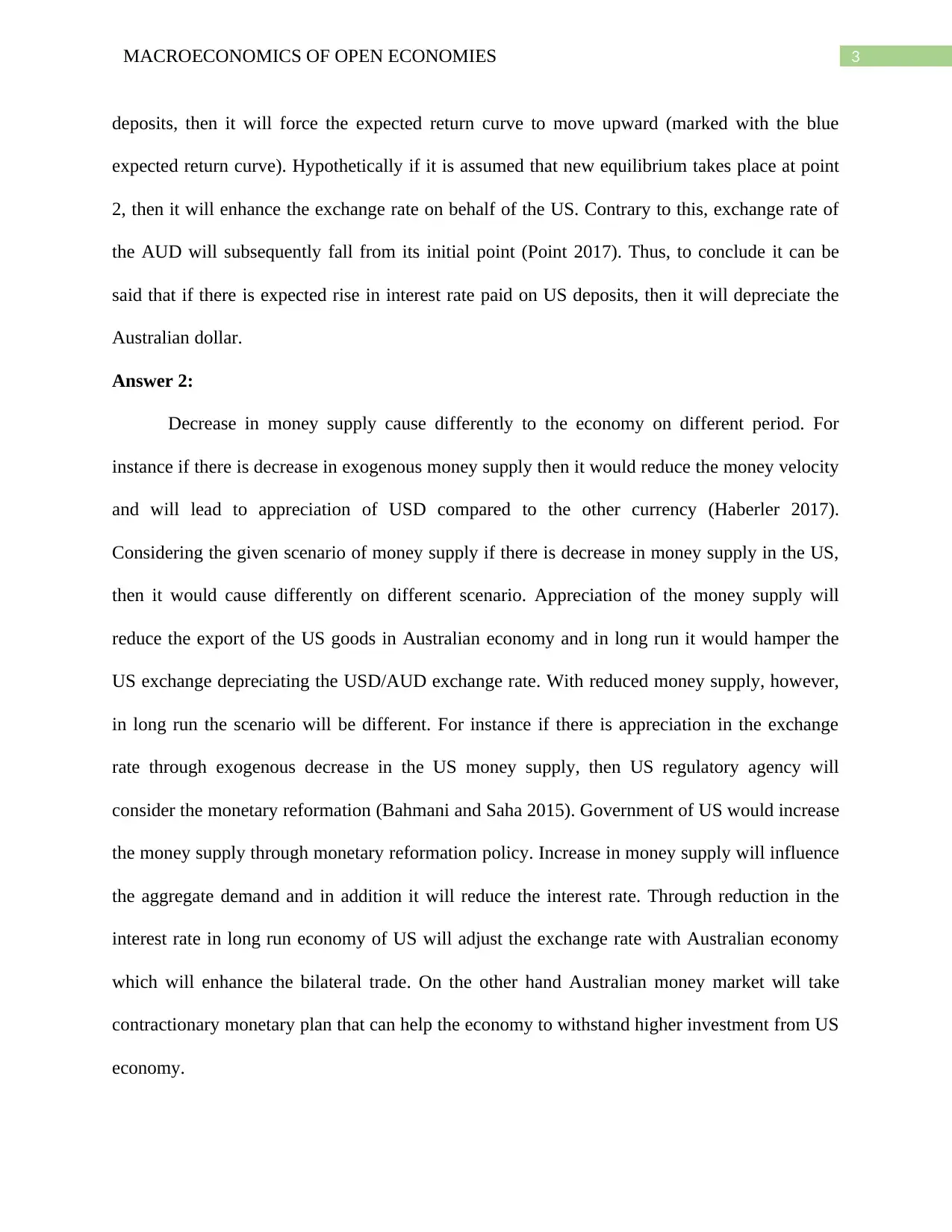
3MACROECONOMICS OF OPEN ECONOMIES
deposits, then it will force the expected return curve to move upward (marked with the blue
expected return curve). Hypothetically if it is assumed that new equilibrium takes place at point
2, then it will enhance the exchange rate on behalf of the US. Contrary to this, exchange rate of
the AUD will subsequently fall from its initial point (Point 2017). Thus, to conclude it can be
said that if there is expected rise in interest rate paid on US deposits, then it will depreciate the
Australian dollar.
Answer 2:
Decrease in money supply cause differently to the economy on different period. For
instance if there is decrease in exogenous money supply then it would reduce the money velocity
and will lead to appreciation of USD compared to the other currency (Haberler 2017).
Considering the given scenario of money supply if there is decrease in money supply in the US,
then it would cause differently on different scenario. Appreciation of the money supply will
reduce the export of the US goods in Australian economy and in long run it would hamper the
US exchange depreciating the USD/AUD exchange rate. With reduced money supply, however,
in long run the scenario will be different. For instance if there is appreciation in the exchange
rate through exogenous decrease in the US money supply, then US regulatory agency will
consider the monetary reformation (Bahmani and Saha 2015). Government of US would increase
the money supply through monetary reformation policy. Increase in money supply will influence
the aggregate demand and in addition it will reduce the interest rate. Through reduction in the
interest rate in long run economy of US will adjust the exchange rate with Australian economy
which will enhance the bilateral trade. On the other hand Australian money market will take
contractionary monetary plan that can help the economy to withstand higher investment from US
economy.
deposits, then it will force the expected return curve to move upward (marked with the blue
expected return curve). Hypothetically if it is assumed that new equilibrium takes place at point
2, then it will enhance the exchange rate on behalf of the US. Contrary to this, exchange rate of
the AUD will subsequently fall from its initial point (Point 2017). Thus, to conclude it can be
said that if there is expected rise in interest rate paid on US deposits, then it will depreciate the
Australian dollar.
Answer 2:
Decrease in money supply cause differently to the economy on different period. For
instance if there is decrease in exogenous money supply then it would reduce the money velocity
and will lead to appreciation of USD compared to the other currency (Haberler 2017).
Considering the given scenario of money supply if there is decrease in money supply in the US,
then it would cause differently on different scenario. Appreciation of the money supply will
reduce the export of the US goods in Australian economy and in long run it would hamper the
US exchange depreciating the USD/AUD exchange rate. With reduced money supply, however,
in long run the scenario will be different. For instance if there is appreciation in the exchange
rate through exogenous decrease in the US money supply, then US regulatory agency will
consider the monetary reformation (Bahmani and Saha 2015). Government of US would increase
the money supply through monetary reformation policy. Increase in money supply will influence
the aggregate demand and in addition it will reduce the interest rate. Through reduction in the
interest rate in long run economy of US will adjust the exchange rate with Australian economy
which will enhance the bilateral trade. On the other hand Australian money market will take
contractionary monetary plan that can help the economy to withstand higher investment from US
economy.
Paraphrase This Document
Need a fresh take? Get an instant paraphrase of this document with our AI Paraphraser
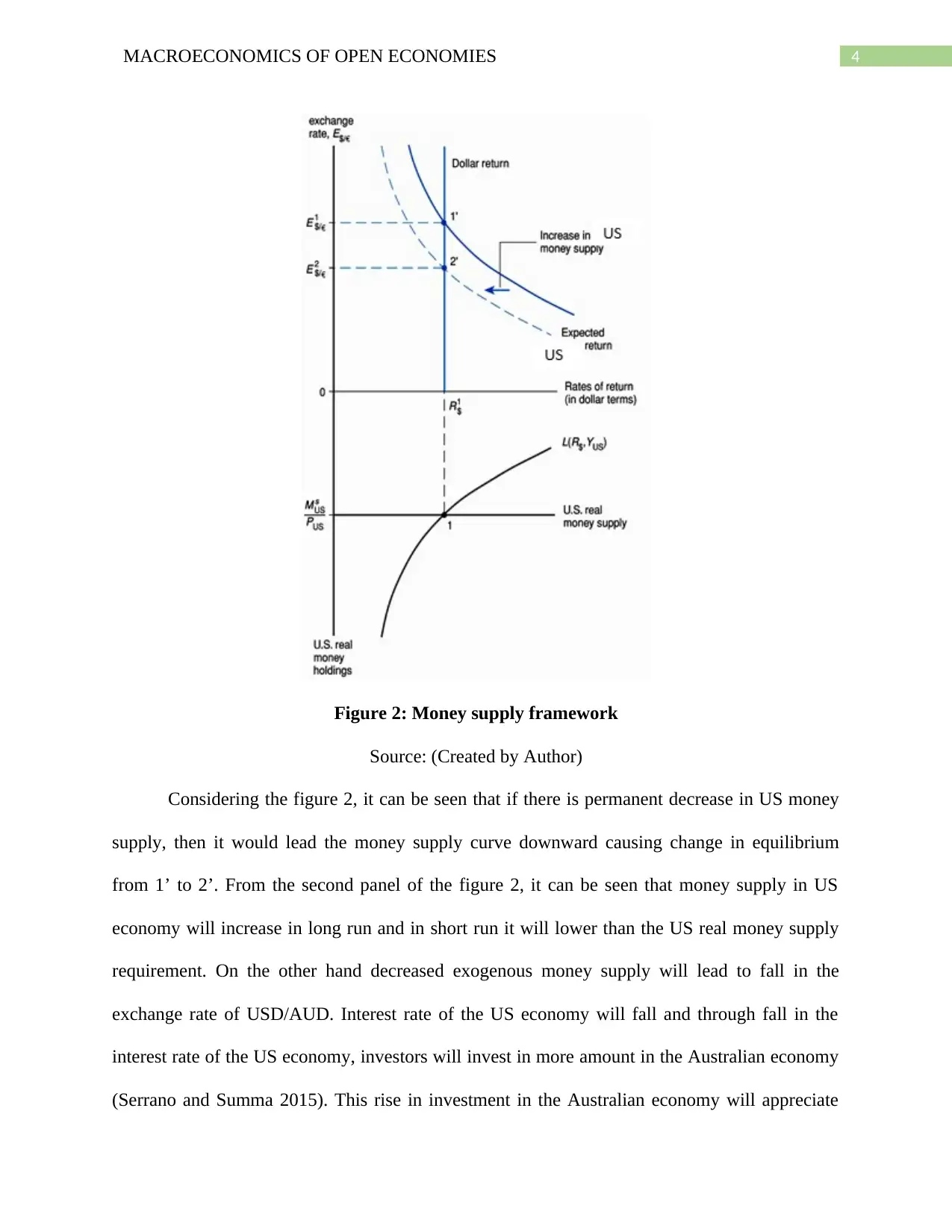
4MACROECONOMICS OF OPEN ECONOMIES
Figure 2: Money supply framework
Source: (Created by Author)
Considering the figure 2, it can be seen that if there is permanent decrease in US money
supply, then it would lead the money supply curve downward causing change in equilibrium
from 1’ to 2’. From the second panel of the figure 2, it can be seen that money supply in US
economy will increase in long run and in short run it will lower than the US real money supply
requirement. On the other hand decreased exogenous money supply will lead to fall in the
exchange rate of USD/AUD. Interest rate of the US economy will fall and through fall in the
interest rate of the US economy, investors will invest in more amount in the Australian economy
(Serrano and Summa 2015). This rise in investment in the Australian economy will appreciate
Figure 2: Money supply framework
Source: (Created by Author)
Considering the figure 2, it can be seen that if there is permanent decrease in US money
supply, then it would lead the money supply curve downward causing change in equilibrium
from 1’ to 2’. From the second panel of the figure 2, it can be seen that money supply in US
economy will increase in long run and in short run it will lower than the US real money supply
requirement. On the other hand decreased exogenous money supply will lead to fall in the
exchange rate of USD/AUD. Interest rate of the US economy will fall and through fall in the
interest rate of the US economy, investors will invest in more amount in the Australian economy
(Serrano and Summa 2015). This rise in investment in the Australian economy will appreciate

5MACROECONOMICS OF OPEN ECONOMIES
the country’s economy while it would deteriorate the trade for the Australia too. Thus, if there is
reduction in the exogenous money supply in US economy, then it would reduce the trade balance
for both the countries while enhancing the exchange rate higher for the Australia and US too. On
the other hand money market of the US will suffer from reduced liquidity while Australian
money market will face boom in liquidity in short run, however, in long run it both the
economies will take monetary policies to gauge the situation.
Answer 3:
General theory of interest rate and inflation highlights that, if there is rise in interest rate
in one trade participating nation, then it will lead to depreciation of exchange rate of another
country’s exchange rate (Grauwe 2018). However, if there is rise in exchange rate in one trade
participating nation and the other appreciates then it can be seen that the government of the other
trade participating nation has been able to signaling the investors that there will be expected
exchange rate appreciation of the country’s currency. In turn it later lead to appreciation of the
spot exchange rate of the country that helps it to have better trade situation.
Considering the case of Australia and US, it can be seen that long are those days gone,
when Australian policy makers used to mechanistically follow the US Fed principles (Chung
2018). Australian now being driving on its economic growth for last 27 years, it is strong enough
in front of small Fed hikes like mentioned in the given question (McCombie and Thirlwall 2016).
Contrary to this US economy has been recently ailing from the 2008 Global Financial Crisis,
which caused a crippling blow to the economy (Tenreyro and Thwaites 2016). Interest rate of the
US economy during those days were lowest among all developed nations that allowed it to face
currency depreciation and the economy was tremendous turmoil. However, contrary to this,
the country’s economy while it would deteriorate the trade for the Australia too. Thus, if there is
reduction in the exogenous money supply in US economy, then it would reduce the trade balance
for both the countries while enhancing the exchange rate higher for the Australia and US too. On
the other hand money market of the US will suffer from reduced liquidity while Australian
money market will face boom in liquidity in short run, however, in long run it both the
economies will take monetary policies to gauge the situation.
Answer 3:
General theory of interest rate and inflation highlights that, if there is rise in interest rate
in one trade participating nation, then it will lead to depreciation of exchange rate of another
country’s exchange rate (Grauwe 2018). However, if there is rise in exchange rate in one trade
participating nation and the other appreciates then it can be seen that the government of the other
trade participating nation has been able to signaling the investors that there will be expected
exchange rate appreciation of the country’s currency. In turn it later lead to appreciation of the
spot exchange rate of the country that helps it to have better trade situation.
Considering the case of Australia and US, it can be seen that long are those days gone,
when Australian policy makers used to mechanistically follow the US Fed principles (Chung
2018). Australian now being driving on its economic growth for last 27 years, it is strong enough
in front of small Fed hikes like mentioned in the given question (McCombie and Thirlwall 2016).
Contrary to this US economy has been recently ailing from the 2008 Global Financial Crisis,
which caused a crippling blow to the economy (Tenreyro and Thwaites 2016). Interest rate of the
US economy during those days were lowest among all developed nations that allowed it to face
currency depreciation and the economy was tremendous turmoil. However, contrary to this,
⊘ This is a preview!⊘
Do you want full access?
Subscribe today to unlock all pages.

Trusted by 1+ million students worldwide
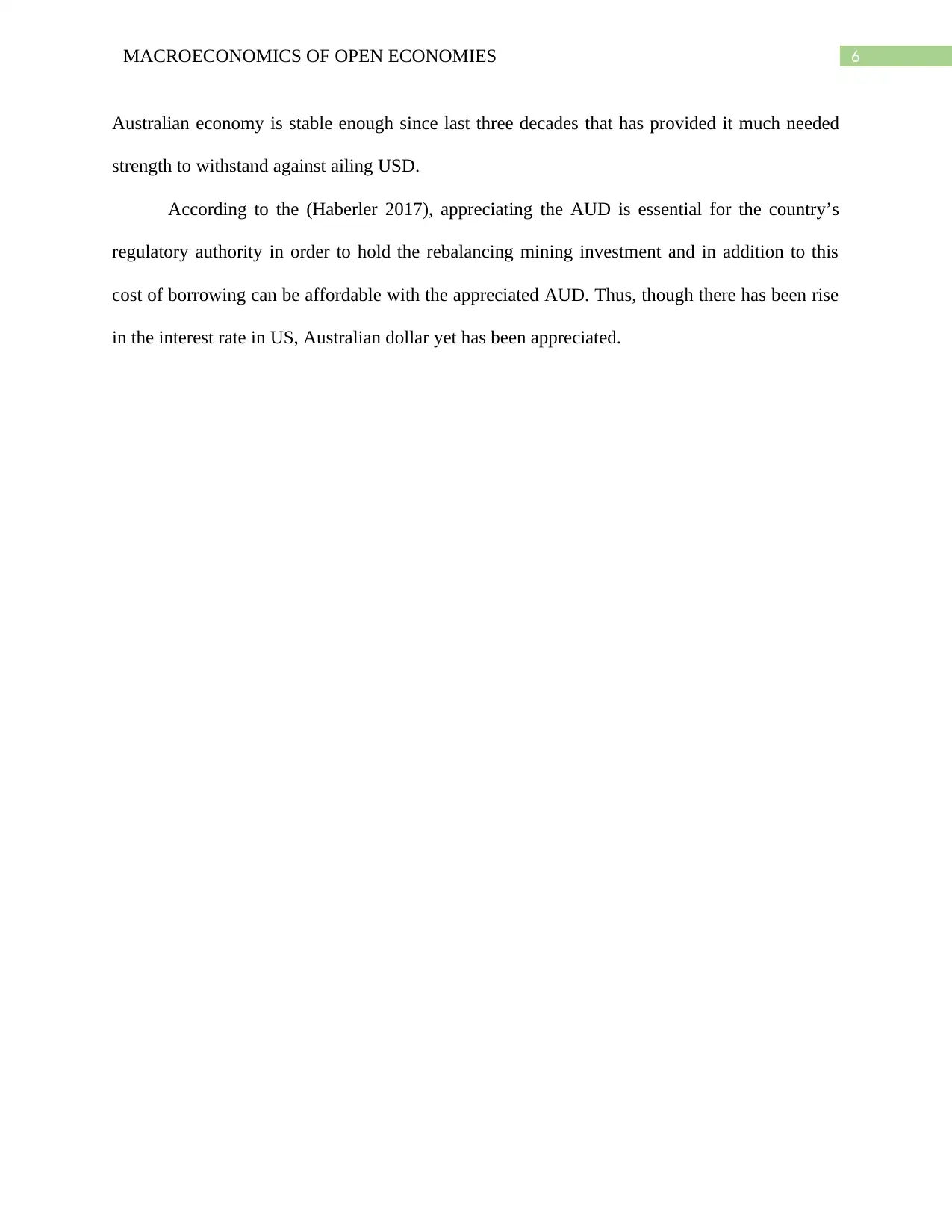
6MACROECONOMICS OF OPEN ECONOMIES
Australian economy is stable enough since last three decades that has provided it much needed
strength to withstand against ailing USD.
According to the (Haberler 2017), appreciating the AUD is essential for the country’s
regulatory authority in order to hold the rebalancing mining investment and in addition to this
cost of borrowing can be affordable with the appreciated AUD. Thus, though there has been rise
in the interest rate in US, Australian dollar yet has been appreciated.
Australian economy is stable enough since last three decades that has provided it much needed
strength to withstand against ailing USD.
According to the (Haberler 2017), appreciating the AUD is essential for the country’s
regulatory authority in order to hold the rebalancing mining investment and in addition to this
cost of borrowing can be affordable with the appreciated AUD. Thus, though there has been rise
in the interest rate in US, Australian dollar yet has been appreciated.
Paraphrase This Document
Need a fresh take? Get an instant paraphrase of this document with our AI Paraphraser
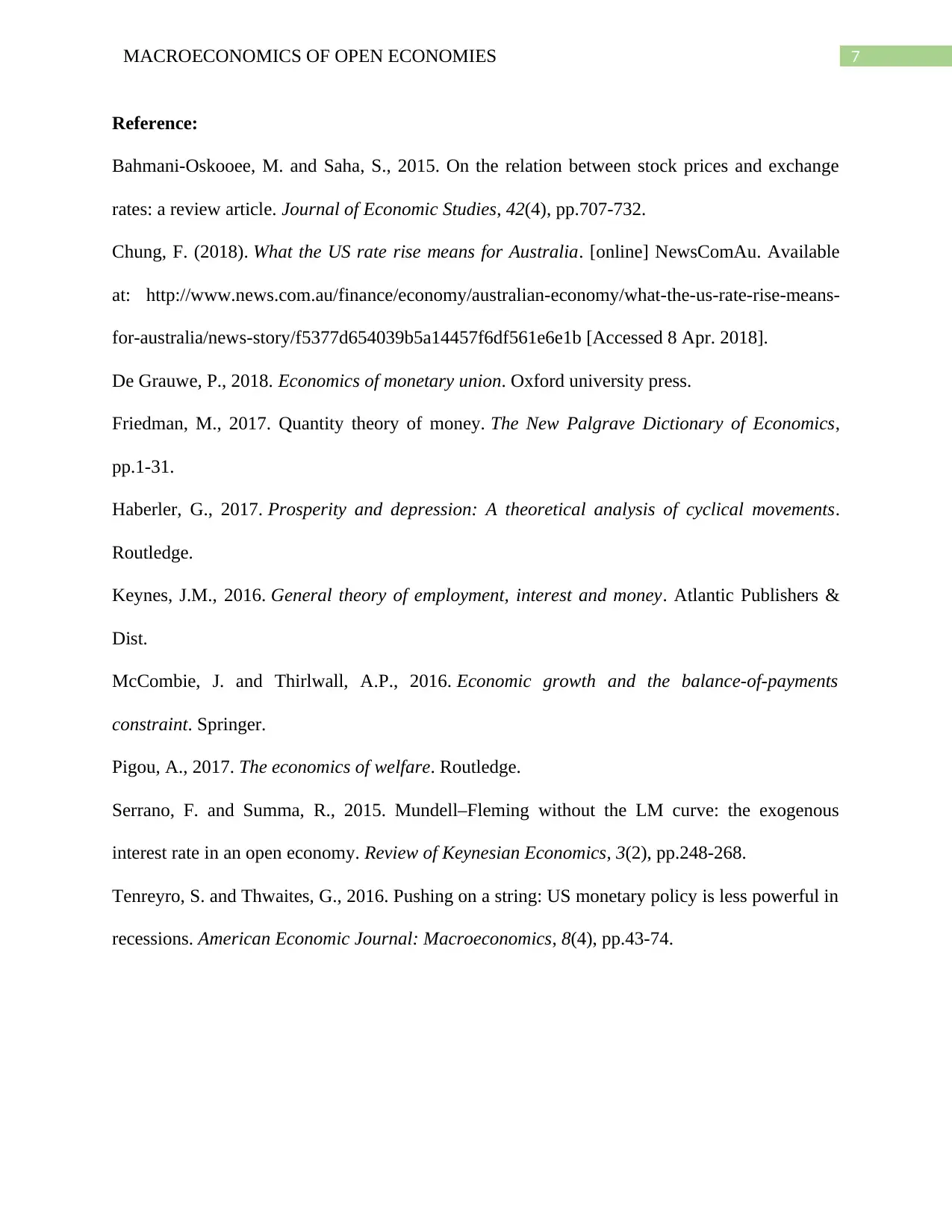
7MACROECONOMICS OF OPEN ECONOMIES
Reference:
Bahmani-Oskooee, M. and Saha, S., 2015. On the relation between stock prices and exchange
rates: a review article. Journal of Economic Studies, 42(4), pp.707-732.
Chung, F. (2018). What the US rate rise means for Australia. [online] NewsComAu. Available
at: http://www.news.com.au/finance/economy/australian-economy/what-the-us-rate-rise-means-
for-australia/news-story/f5377d654039b5a14457f6df561e6e1b [Accessed 8 Apr. 2018].
De Grauwe, P., 2018. Economics of monetary union. Oxford university press.
Friedman, M., 2017. Quantity theory of money. The New Palgrave Dictionary of Economics,
pp.1-31.
Haberler, G., 2017. Prosperity and depression: A theoretical analysis of cyclical movements.
Routledge.
Keynes, J.M., 2016. General theory of employment, interest and money. Atlantic Publishers &
Dist.
McCombie, J. and Thirlwall, A.P., 2016. Economic growth and the balance-of-payments
constraint. Springer.
Pigou, A., 2017. The economics of welfare. Routledge.
Serrano, F. and Summa, R., 2015. Mundell–Fleming without the LM curve: the exogenous
interest rate in an open economy. Review of Keynesian Economics, 3(2), pp.248-268.
Tenreyro, S. and Thwaites, G., 2016. Pushing on a string: US monetary policy is less powerful in
recessions. American Economic Journal: Macroeconomics, 8(4), pp.43-74.
Reference:
Bahmani-Oskooee, M. and Saha, S., 2015. On the relation between stock prices and exchange
rates: a review article. Journal of Economic Studies, 42(4), pp.707-732.
Chung, F. (2018). What the US rate rise means for Australia. [online] NewsComAu. Available
at: http://www.news.com.au/finance/economy/australian-economy/what-the-us-rate-rise-means-
for-australia/news-story/f5377d654039b5a14457f6df561e6e1b [Accessed 8 Apr. 2018].
De Grauwe, P., 2018. Economics of monetary union. Oxford university press.
Friedman, M., 2017. Quantity theory of money. The New Palgrave Dictionary of Economics,
pp.1-31.
Haberler, G., 2017. Prosperity and depression: A theoretical analysis of cyclical movements.
Routledge.
Keynes, J.M., 2016. General theory of employment, interest and money. Atlantic Publishers &
Dist.
McCombie, J. and Thirlwall, A.P., 2016. Economic growth and the balance-of-payments
constraint. Springer.
Pigou, A., 2017. The economics of welfare. Routledge.
Serrano, F. and Summa, R., 2015. Mundell–Fleming without the LM curve: the exogenous
interest rate in an open economy. Review of Keynesian Economics, 3(2), pp.248-268.
Tenreyro, S. and Thwaites, G., 2016. Pushing on a string: US monetary policy is less powerful in
recessions. American Economic Journal: Macroeconomics, 8(4), pp.43-74.
1 out of 8
Related Documents
Your All-in-One AI-Powered Toolkit for Academic Success.
+13062052269
info@desklib.com
Available 24*7 on WhatsApp / Email
![[object Object]](/_next/static/media/star-bottom.7253800d.svg)
Unlock your academic potential
Copyright © 2020–2025 A2Z Services. All Rights Reserved. Developed and managed by ZUCOL.





